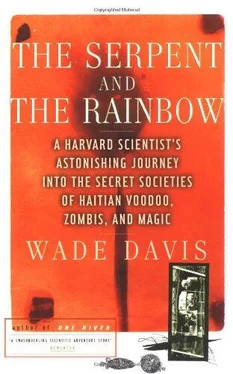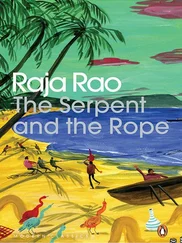Wade Davis - The Serpent and the Rainbow
Здесь есть возможность читать онлайн «Wade Davis - The Serpent and the Rainbow» весь текст электронной книги совершенно бесплатно (целиком полную версию без сокращений). В некоторых случаях можно слушать аудио, скачать через торрент в формате fb2 и присутствует краткое содержание. Год выпуска: 1985, Издательство: Simon & Schuster, Жанр: Старинная литература, на английском языке. Описание произведения, (предисловие) а так же отзывы посетителей доступны на портале библиотеки ЛибКат.
- Название:The Serpent and the Rainbow
- Автор:
- Издательство:Simon & Schuster
- Жанр:
- Год:1985
- ISBN:нет данных
- Рейтинг книги:5 / 5. Голосов: 1
-
Избранное:Добавить в избранное
- Отзывы:
-
Ваша оценка:
- 100
- 1
- 2
- 3
- 4
- 5
The Serpent and the Rainbow: краткое содержание, описание и аннотация
Предлагаем к чтению аннотацию, описание, краткое содержание или предисловие (зависит от того, что написал сам автор книги «The Serpent and the Rainbow»). Если вы не нашли необходимую информацию о книге — напишите в комментариях, мы постараемся отыскать её.
The Serpent and the Rainbow — читать онлайн бесплатно полную книгу (весь текст) целиком
Ниже представлен текст книги, разбитый по страницам. Система сохранения места последней прочитанной страницы, позволяет с удобством читать онлайн бесплатно книгу «The Serpent and the Rainbow», без необходимости каждый раз заново искать на чём Вы остановились. Поставьте закладку, и сможете в любой момент перейти на страницу, на которой закончили чтение.
Интервал:
Закладка:
When we drove up to the house at Mariani late that night, four men were waiting for us. Max Beauvoir introduced me but not them, saying simply that they wanted to know what I was doing in Haiti. Opening my pack, I laid Marcel Pierre’s prepared poison on the table. One who seemed to be their leader, a short, gruff man with an enormous belly, took the poison, poured it into the palm of his hand, and stirred it with his index finger. Turning to Beauvoir, he said, “This is too light to be anything.” Max laughed, and the others joined in. The four stayed long enough to have a drink and then left without waiting to see the ceremony.
“Who were they?” I asked Max as soon as they were gone.
“Important men.”
“Houngan?”
He nodded.
I spent the next several days in the south looking for plantings of datura and the Calabar bean. All the species of datura that had been reported in Haiti were feral and quite weedy, and I had expected to find them growing in disturbed sites almost anywhere. Curiously, after walking the hills along the road over the mountains toward the southern port of Jacmel, and the barren fields along the east coast as far as Anse-à-Veau, I found but a single specimen—a scandent shrub of Datura metel , at a house site in a small coastal village, planted, I was told, as a remedy for asthma. As for the Calabar bean, I was equally disappointed. Having combed a number of low swampy habitats, and having perused the dusty herbarium at the Ministry of Agriculture, I found no evidence that the plant had become naturalized in Haiti.
But then, out with Max Beauvoir in the mountains above Port-au-Prince, I did find a species of the tree datura of the genus Brugmansia , planted as an ornamental. These are short, gnarly trees, almost invariably covered by large pendulous trumpet-shaped flowers. Though quite distinct in appearance from the spindly datura shrubs, they share the same active chemical principles and are equally toxic if ingested. This, in fact, was the same species used by the curanderos of northern Peru, the one known as cimora. I knew that the tree daturas were native to South America and had only recently been introduced into Haiti, but I was uncertain whether its special properties had been identified by the Haitian peasants. Apparently they had, for no sooner had I begun to collect specimens than a small rancorous group of hill peasants gathered, demanding to know why I was cutting that particular tree. But as soon as Beauvoir said a few words, their demeanor changed dramatically. They approached me expectantly, and a couple of young boys clambered up the trees for flowers. I turned to Beauvoir for an explanation.
“I told them that you are Grans Bwa, the spirit of the woods.” He indicated an old woman, gnawing on a small pipe. “She has asked that you bathe them with herbs. I explained that we have no time. She argues that at least you must bathe the children. But come, I told her perhaps another time.”
At that, I gathered my specimens and started down the hill toward the road. By then the ground at the base of the tree was blanketed with blossoms and the people had started to sing:
Leaves in the woods, call me
Oh, leaves in the woods, call me
Leaves in the woods, call me
Ever since I was small, I have danced .
Intrigued by the unexpected scarcity of datura in the fields of the south, I decided it was time to look up the last of my three leads on this increasingly enigmatic assignment. On a sultry afternoon when the capital smelled of spice, I contacted Lamarque Douyon, the psychiatrist who had been working with Clairvius Narcisse.
A secretary showed me into a stark office dominated by a massive mahogany desk and two photographs, each hung on a turquoise wall in frames that matched the desktop. One was a poster-sized presidential portrait of Dr. François Duvalier, a fixture that in most Haitian government offices has long since been replaced by a likeness of his son. The smaller photograph showed a young, almost unrecognizable Nathan Kline in a crewcut and horned-rimmed glasses. On another wall hung a plaque acknowledging the contributions of the American research institutions that had helped finance the initial construction of the clinic in 1959, and a second plaque thanking the foreign pharmaceutical companies for their contributions of free drugs for the first two years of operation. Beneath the barred windows stood a shock therapy unit, so archaic that it evoked a perverse nostalgia. The entire room was a freeze frame of the late fifties, the only time when research funds had flowed. Since then, not even the furnishings had changed.
Lamarque Douyon impressed me as a benign, soft-spoken man hampered not only by lack of funding but by the difficulties of reconciling his Western scientific training with the unique rhythms of his own culture and its thoroughly African foundations. He is a physician who straddles two very different worlds. As Haiti’s leading psychiatrist and the director of its only psychiatric institute, he remains accountable to a peer group of foreign scientists; yet as a clinician he treads through an utterly non-Western landscape where European notions of mental health lose their relevance.
Douyon’s scientific interest in the zombi phenomenon dates to a series of experiments he conducted in the late 1950s while completing his psychiatric residency at McGill University. That was the heyday of the early psychopharmacological research. Psychiatrists, having discovered that certain mental disorders could be successfully treated with drugs, were actively experimenting with a number of potent psychotropic substances on human subjects under controlled circumstances. What Douyon observed during some of these experiments reminded him of accounts of zombis he had heard as a child; he recalled as well the prevalent belief among many Haitians that zombis were created by a poison that brought on a semblance of death from which the victim would eventually recover. By the time he returned to Haiti in 1961 to take his position as director of the Centre de Psychiatrie et Neurologie, he, like Kline, was convinced that such a poison existed.
“Zombis cannot be the living dead,” he told me. “Death is not merely the loss of bodily function, it is the material decay of the cells and tissues. One does not wake up the dead. However, those who have been drugged may revive.”
“This zombi preparation, Dr. Douyon, do you have any idea what it contains?”
“Snakes, tarantulas, most anything that crawls.” He hesitated. “Or leaps—they say there is always a large toad. Human bones … but they go into everything.”
“Do you know the species of toad?”
“No, but I don’t think … there is a plant that grows here. We call it the concombre zombi , the zombi’s cucumber.”
“Oh, you mean datura.” I shared with him my thoughts about the Calabar bean.
He told me that he had never heard of the plant in Haiti and returned to the subject of datura. “When I was at McGill, my advisor suggested that I test a number of plants commonly associated with the zombi folklore. We fed a preparation of datura leaves to mice and induced a catatonic state for three hours. Unfortunately these experiments stopped when Professor Cameron left the institute.”
“Was that Ewen Cameron?”
“Yes, you know of him?”
“By reputation.” But I knew nothing of this connection. The late Ewen Cameron had been the director of the Allan Institution in Montreal during what Kline liked to refer to as the dark ages of psychiatry. Between 1957 and 1960 he conducted psychic driving and brainwashing experiments, funded partially by the CIA. He was notorious for combining LSD with massive doses of electroshock therapy in his studies of schizophrenia. After he left the institution, the subsequent director promptly banned all of Cameron’s therapeutic techniques.
Читать дальшеИнтервал:
Закладка:
Похожие книги на «The Serpent and the Rainbow»
Представляем Вашему вниманию похожие книги на «The Serpent and the Rainbow» списком для выбора. Мы отобрали схожую по названию и смыслу литературу в надежде предоставить читателям больше вариантов отыскать новые, интересные, ещё непрочитанные произведения.
Обсуждение, отзывы о книге «The Serpent and the Rainbow» и просто собственные мнения читателей. Оставьте ваши комментарии, напишите, что Вы думаете о произведении, его смысле или главных героях. Укажите что конкретно понравилось, а что нет, и почему Вы так считаете.












